Washingtonia: description, features of home care
Washingtonia began to be used as a decorative plant not so long ago, however, it won success among designers of residential and office premises, and is also popular in landscape design, acting as an interesting element of greenhouses and winter gardens. It is about its features and growing rules that will be discussed in the article.
Plant description
Washingtonia is a palm tree well-known in Mexico and the southern states of America. It belongs to evergreens that tolerate not only hot, but also frosty weather.
The tree can grow up to 20-30 m with a column diameter of 1 m. The trunk is light brown in color and covered with fibers, and fallen, dried leaves create a kind of skirt, because they do not fall to the ground.

The leaves are cirrus, dissected, segmented, typical for all plants of this species. The palm fan grows larger as Washington grows and reaches a maximum size with leaves 1.5 m long. Petioles of the leaves are rather short and have spikes characteristic of this species. The edge of the fan-shaped leaves is framed by fibers sticking out to the sides, which are outwardly similar to the sticking threads, which is one of the distinguishing features of this type of palm plant. Did you know? Palm " Washington " was named after the first president of the United States - George Washington. The plant blooms with panicle inflorescences on long peduncles, the size of which can be up to 3 m. Flowers are painted in shades from white to yellow. After Washington fades, it forms fruits in the form of black berries that can be eaten.
There are 2 types of plants:
- filamentous or nitrous (Washingtonia filifera);
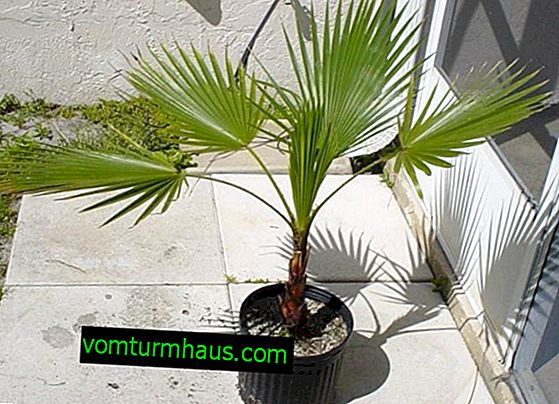
- strong or robusta (Washingtonia robusta), which in Mexico is called sonora (Washingtonia sonorae).
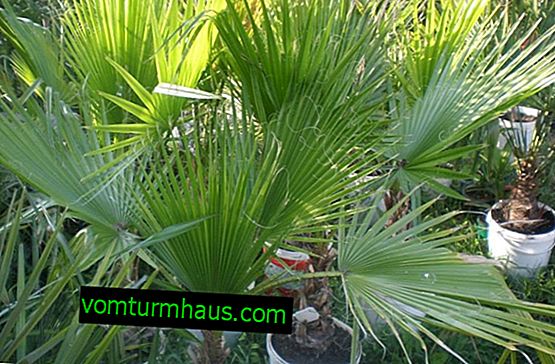
Pros and cons of growing
- The advantages of the plant are called:
- rapid growth of palm trees;
- for wild representatives - tall;
- the ability to tolerate cool and even frosty temperatures, with a maximum of –13 ° C outside the window. The plant feels normal at +5 ... + 10 ° C, therefore it can be used for landscape design on open ground in a temperate climate;
- decorative palm trees do not require special growing and care conditions, can be compact;
- Washington fibers serve as raw materials for the manufacture of wicker furniture and baskets;
- the fruits are ground into flour;
- petioles and plant leaves are used in cooking.
- Be wary of treating a plant, because:
- petioles washingtonia nitenosum along the entire length have sharp spikes;
- dried leaves on a palm tree in the natural environment, often becomes a shelter for rodents and birds;
- the need to trim the "skirt" from the fallen leaves, since they make the appearance of the tree not so attractive.
What conditions are necessary for Washington?
Growing a palm of this type does not imply the creation of special conditions, but you should listen to the following recommendations:
- Place . For Washington, it is better to choose a secluded corner without drafts, regardless of whether the palm grows indoors or is on open ground. The plant does not like strong gusts of wind. You should not keep a palm tree in a stuffy room, a great option for growing it would be to place the plant on a terrace or balcony, controlling the weather on the street, as prolonged damp weather can negatively affect it.
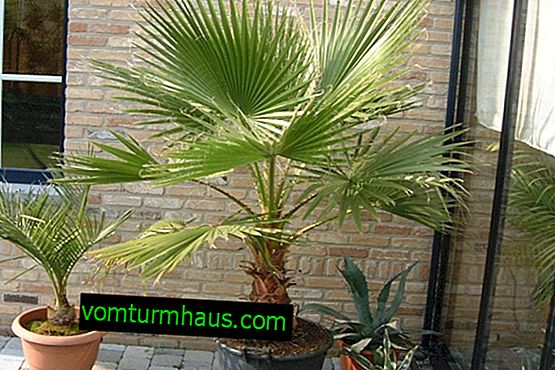
- The light . Since palm trees come from Mexico, Florida and California - the southern and sunny edges, it is better to choose the east or west side of the house for home washingtonia. So the plant will receive enough light. Excessive sunshine can be detrimental to young palm trees due to overheating and lack of fresh air if it is standing on a window on the south side. Read also about home care for butia palm. It is recommended to regularly rotate the plant with different sides to the sun, so that it grows smooth, beautiful and well developed. There is a lot of light for the palm, at least 16 hours a day, and if the daylight is short, then it is necessary to provide additional, artificial lighting, for which fluorescent lamps can be used.
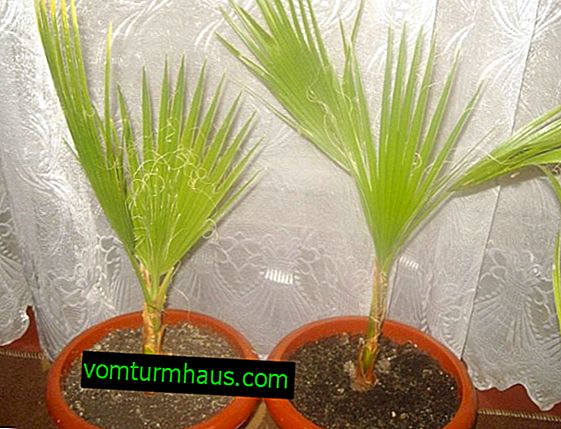
- Temperature The plant grows well in warm conditions, when in summer and spring the air temperature is in the range +20 ... + 25 ° C, and it is cool. In the natural environment, it normally tolerates temperatures of +5 ... + 10 ° C and short-term freezing; at home, it is recommended that the air be also cooled to +10 ... + 15 ° C in winter, as the plant goes to rest. Therefore, it is not worthwhile to transfer the plant from the balcony or the hall to heat if the indicator of the thermometer has not dropped below the specified value. In summer, during the heat, the plant needs fresh air, which will prevent the leaves from drying out.

- Humidity . The best indicator is 60–80%. To maintain this level, it is necessary to irrigate the plant from the spray gun in hot weather in the morning and evening, and in the winter it is enough to wipe the palm leaves with a damp cloth. To improve humidity, you can use a pan with water, which is located next to the plant, especially this is true in the heating season.
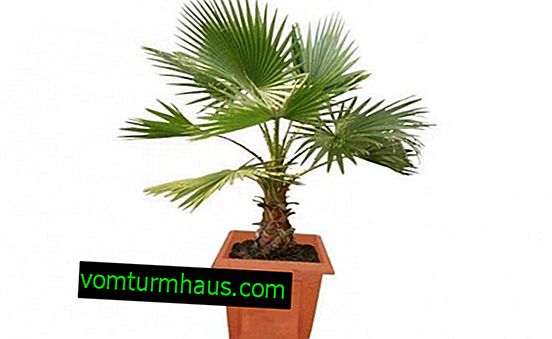
Home Care
At home, caring for Washington includes:
- compliance with optimal conditions for its cultivation;
- correctly selected soil;
- regularity of watering and fertilizing the soil;
- timely pruning;
- compliance with transplant technology.
How to water and fertilize
Watering Washington should be plentiful enough so that the soil is moist, although the palm may be in dry soil for some time. This happens in the summer once a week, in the cold season - less often. It is important to monitor the condition of the soil so that it does not dry out and is not too wet. Before watering the plant, it is recommended to prepare the water, it should be warm and settled. It is worth noting that the amount of watering depends on the season, so in winter it is much less than in hot weather. Did you know? The formation of a “skirt” of fallen leaves in Washington is a serious source of fire hazard. In Florida, the native places of these trees, palm trees can reach 30 meters and during a thunderstorm they often light up and burn like torches. To prevent this situation, it is necessary to use special lifting equipment and climbers that cut dry foliage. To plant Washington, clay-turf soil is needed, which has a dense structure with a slightly alkaline environment. During flowering and intensive growth, which occurs in spring and summer, the plant requires additional resources and is fed. For this, it is recommended to use mineral complexes, fertilizer for palm trees with a large amount of iron. The procedure is carried out twice a month. During the period when the plant is at rest, in winter and autumn, fertilizing with palm fertilizers is not required.

Pruning
This procedure is required for a beautiful appearance of the plant. It is necessary to trim the leaves, petioles, which are dried up and in nature remain on the tree, clinging to the fibers of the trunk and forming a characteristic "skirt".
Important! Leaves can be cut only when the petiole has become dry, otherwise other leaves may also begin to dry. It is worth remembering the thorns on the petioles so as not to be injured when pruning.
Transplant Features
First of all, you need to decide in which cases a Washington transplant is required:
- the age of a young tree reached 1-2 years and the plant grew from a small pot;
- the roots of an adult tree are already poorly placed in the same pot, protrude out through the drainage holes.
- new deep pot with drainage holes;
- drainage, which is necessary in large quantities;
- priming.
Video: correct palm transplant washingtonia nitenosa
Then, the interval of transplants is slightly increased, so 5-year-old Washington should be transshipped into a new pot no more than once every 3-5 years, and trees that have reached 10-year-old age are no longer recommended to be replanted, only to update the topsoil and add soil to the formed emptiness. On average, at home, young palm trees are grown no more than 8 years of age. To grow this palm tree, soil can be purchased or created independently.
Washington's fit:
- substrate for palm species, which can be found in any flower shop;
- a mixture of turf, leafy soil and humus, with the addition of sand.
- turfy earth mixture - 1 part;
- sheet land - 1 part;
- peat / humus - 1 part;
- sand - 0.5 parts.
For transplanting large adult palm trees, turf land should take twice as much as other components. The earth can be made more nutritious by adding a few fertilizers that will help the adaptation of the tree in a new pot and further development.
The transplant technology is as follows:
- A pot with a palm tree is turned on its side. The tree trunk should be held tightly by hands, and then with a little effort to pull it out of the flowerpot with an earthen lump.
- Carefully transfer the palm into a new, larger and larger pot.
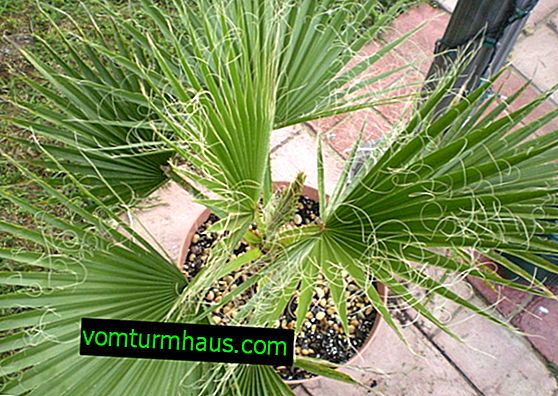
Propagation and cultivation
Palm trees are propagated by very small, oval seeds.
The palm breeding process consists of 3 stages:
- Preparation of planting material.
- Sowing seeds.
- Growing and caring for seedlings and sprouts.
- Germinating seeds independently at home, it is necessary to prepare a special earthen mixture of peat, sawdust, sand and moss.
- Planting material is prepared by first slightly damaging the seed coat. To do this, the seed can be slightly scratched, lightly treated with emery paper, or even filed with a file. Then it is soaked in warm water for almost a day. This procedure is called scarification and helps seed germination faster because it makes the shell softer.
- Seeds are planted shallowly, immersed in the soil no more than 1 cm, and then watered.
- Seeds germinate faster in warm conditions, for which planting can be covered with film or glass and put in a warm place.
Video: Palm seed propagation by washingtonia
Optimal conditions for seed germination:
- temperature +25 ... + 30 ° C;
- diffused light.
Flowering period
At home, seeing the flowering of Washington is almost unrealistic. Such cases were recorded in trees aged at least 13–15 years old, grown in specialized greenhouses. It is worth noting that at home palm trees of this species grow, on average, about 10 years.
Signs of disease or pests
In the conditions of growing palm trees in an artificial environment, problems may arise due to improper care, which can cause such diseases:
- Spotting on leaf blades . The reason is a sharp temperature drop.

- Drying foliage at the ends . The reason is overdried indoor air, dry soil, lack of potassium in the soil.
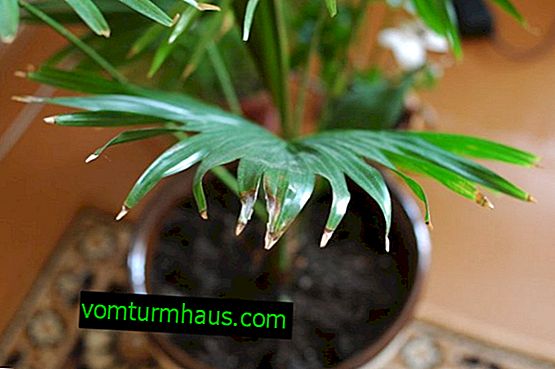
- Change in leaf color : darkening, blanching, yellowing. The reason is insufficient watering.
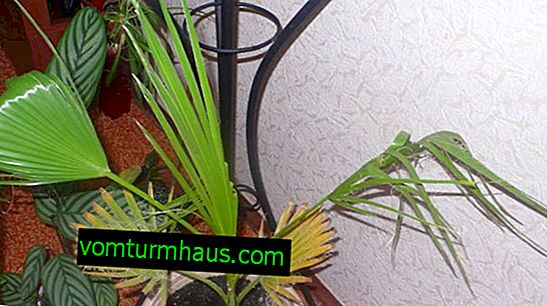
- Leaf fall . The reason is the low humidity in the room where the plant is located.

- Rotting of the roots . The reason is either abundant and too frequent watering, as a result of which, the soil does not dry out enough, remains too wet, or poor drainage, which makes it difficult to drain excess water during irrigation, due to which stagnation of the liquid occurs and the roots begin to deteriorate.

- whitefly, insect with white plaque on wings;
- spider mite, very small, about 0.5 mm tall, but extremely dangerous pest;
- mealybug sucking juice from a plant;
- scab, sucking an insect without legs and wings.
The following methods are used to combat:
- processing plants with special solutions - insecticides, in case of serious damage to the palm;
- wiping with a soap solution made from a laundry detergent.















